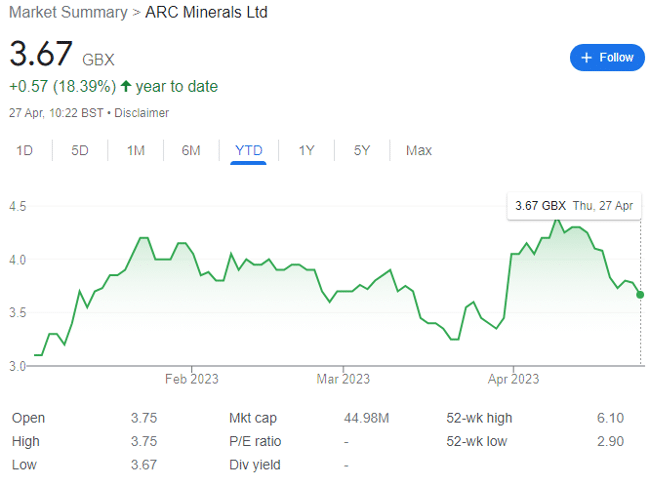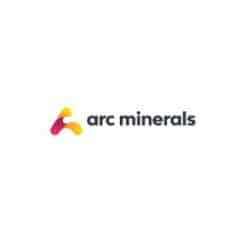ARCM shares are where KOD shares were — an excellent deal has been signed and the market remains asleep. This won’t last very long.

There are currently two copper exploration companies with prospects in the Zambian Copperbelt that have captured my attention. The first is micro-cap Tertiary Minerals (LON: TYM), which I have covered in detail here – and the second is ARC Minerals (LON: ARCM).
I contacted Executive Chairman Nick von Schirnding for a brief personal view. I hope to get some more specific thoughts after the drilling season concludes, but the Chair is clearly very positive on the company’s prospects.
The full Q&A is just below the article.

Long-time readers will know that I’m heavily invested in a variety of battery metals small-caps — my favourites are those London-listed with operations in Africa — and companies like PREM, KOD, MARU et al have all delivered significant returns so far.
I have very simple reasons for this strategy. Despite the loud protestations from some quarters, the AIM market is well-regulated and launching an IPO requires serious due diligence. This reduces the risk associated with operating in some African states — even though many have made serious efforts to clean up their governmental practices over the past decade.
And I’ve already covered the gaping chasm that is the copper supply gap in depth here. There’s a reason why BHP snapped up Oz Minerals, and why Glencore is desperately pursuing Teck Minerals with the zeal of a sailor on shore leave. The larger fish need more mines, and the smaller fish have already bought up the rights.
Of course, it’s fair to note that with a £45 million market cap, ARCM is still speculative.
ARCM shares themselves exhibit the typical AIM exploratory miner characteristics: they’re up 18% year-to-date, down 13% over the past year, and up 49% in five years. And at 3.67p today, ARCM stock was changing hands for a record 7.55p in mid-March 2021, and 2.35p in early January 2022.
This volatility is inevitable — the company has the rights to an exceptionally prospective copper project, but one which has only seen preliminary work. With definitive results likely to take many months, traders and investors alike will be regularly dipping in and out.
Not me though. I’m an investor for the long term.
ARCM Copper Projects
Other than Zambia, Arc Minerals has a 75% interest in Alvis-Crest Limited, the holder of two prospecting licences in Botswana’s Kalahari Copper Belt — the Virgo Projects. These 201 square km prospects are located in an emerging copper district within the Kalahari district, and within 10km and 50km of Cupric Canyon’s Zone 5 and the Banana Zone copper projects respectively, well-known as the two largest copper projects on the KCB.
But it’s the North-Western Zambian licenses that could be company-making. These projects are located within the Domes region of the Zambian Copperbelt near world-class producing mines including First Quantum Minerals’ Sentinel and Kansanshi mines and Barrick’s Lumwana mine — and importantly, these licences are some of the last dome-related areas to be explored in detail.
As investors will know, these projects were previously explored through an Equinox Minerals and Anglo American Joint Venture during the late 1990s as part of the Kabompo Project. ARCM’s areas under license encompass nine of 30 exploration ranked targets, including the top seven ranked targets.
This matters because FQM’s Sentinel copper mine — which produces over 250,000 tonnes of copper per year — was originally ranked number 22 of the original 30 targets. At the time, it had an exploration target size of six million tonnes of ore, but this was eventually upgraded to a gigantic one billion tonnes.
ARCM has carried out 22,000 metres of drilling, analysed 75,000 soil samples, and flown 5,700 line km’s of airborne geophysical surveys. But the company needed to get a large-cap JV partner on board to bring the project anywhere close to production — and accordingly, entered a non-binding agreement with Anglo in May 2022.
Anglo American JV
On 20 April 2023, the deal was officially signed and made legally binding by both parties.
ARCM signed through its subsidiary, Unico Metals (67% shareholding). Under the agreement, Anglo will have the right to eventually ramp up to 70% ownership of the JV, based on meeting capital injection requirements. It’s important to note that the deal needs to be signed off the Zambian state, though given Anglo’s status this is likely to be a formality.

The most recent RNS notes that ‘all other substantive commercial terms of the proposed Joint Venture remain unchanged from those previously announced on 12 May 2022.’
These terms are fairly simple:
Anglo has the right to retain an ownership interest of 51% by:
- funding exploration expenditures worth $24 million ‘on or before the date that is 180 days after the third anniversary of the Phase 1 End Date’
- making cash payments to Arc Minerals totalling up to $14.5 million, comprising $3.5 million after signing the JV, $1 million on each of the first three anniversaries of signing, and $8 million by the Phase 1 end date
After Phase 1 completes, Anglo can then bring its ownership interest up to 60% by:
- funding $20 million of additional exploration expenditures within 2 years of the Phase 1 End Date — this would be the Phase 2 End Date
After Phase 2 completes, Anglo can then bring its ownership interest up to 70% by:
- funding $30,000,000 within 2 years of the Phase 2 End Date
Schirnding enthuses that he is ‘very pleased that we have signed a binding Joint Venture Agreement with Anglo American, a major turning point for Arc Minerals.’
Next steps
Preliminary work with Anglo has already begun — and the Chair is currently on the ground in Zambia. The plan is to get started with the drilling as soon as possible, which will be when the dry season begins in a few weeks’ time. There is some urgency for both parties as there is only a six-month window to get results before the weather forces a halt.
For investors looking at the current share price — and I can only speak to long-term holders — consider this:
ARCM shares are now trading for less than before the JV was signed with Anglo.
ARC Minerals will eventually end up owning 30% of the JV, and they’re going to be drilling a massive prospect next-door to multiple world-class copper mines — one of which has already been judged in the past as an inferior target.
And assuming all goes well, ARCM will be given $14.5 million in cash — some of which can be used to develop the Virgo Projects in Botswana.
In terms of risk-reward, this is very one-sided. I’m in.
This article — including question responses — has been prepared for information purposes only by Charles Archer. It does not constitute advice, and no party accepts any liability for either accuracy or for investing decisions made using the information provided.
Further, it is not intended for distribution to, or use by, any person in any country or jurisdiction where such distribution or use would be contrary to local law or regulation.
Full Q&A with Executive Chairman Nick von Schirnding
1. Much of ARCM’s success hinges on its copper interests in Zambia. The country enjoys relative political stability in the region, but should investors worry about political changes in the country given the long-term nature of investing in mines?
No, investors should not be worried, as Zambia has been a politically stable democracy for many years. The recent elections are testament to that and President Hichilema‘s administration has a very focused and active agenda to transform the country economically making it an attractive destination for foreign investment and ensuring a strong governance framework
2. Following from this, what’s your view on Zambian mining reforms being undertaken by President Hichilema- both positive and negative?
The administration is working hard to ensure mining investment continues, with ambitious targets for copper production. The recent actions at the mining cadastre are testament to that with a major clean up having been affected.
3. A key ESG focus on western-listed developers in Africa concerns potential exploitation of resources without ‘giving back.’ How is ARCM working to benefit Zambians?
Arc is very much focused on ensuring we have a license to operate. It’s critical that we work closely with the local community and chieftains. We have a number of initiatives with the local community including upgrading infrastructure and providing assistance for local businesses, most recently with a honey production cooperative in Mwinalungu.
4. Much has been made of the critical minerals shortage. I have covered the long-term copper supply gap in detail, but do you anticipate short-term profitability issues in the event of a global recession, especially as mining costs increase in this inflationary environment? Isn’t overall mining capex falling at present?
No, I don’t anticipate much of a squeeze on margins — while there are short term pressures on certain input costs these are likely to be temporary in nature, with copper prices continuing to stay at elevated levels with limited new supply coming online.
5. Do you think that ARCM’s Zambian claims have the potential to be world-class given their location adjacent to the well-known Copperbelt? What about the claims in Botswana?
Arc’s tenements in northwest Zambia are one of the most attractive undeveloped copper prospects in the world. The other side of the Kabompo domes region today houses three major multi-billion-dollar copper operations. We are convinced that our side of the dome houses at least one or more tier 1 deposits. Our tenements in Botswana are also very attractive and adjacent to an existing copper operation in the KCB.
6. I recently covered the JV partnership between Newcrest and Greatland Gold at the Haverion project in Australia and commented that Newcrest as the larger partner holds significant practical power over the junior. Do you think that despite significant de-risking, there will be an implied power imbalance within the JV between £59 million ARCM and £34 billion Anglo American?
I wouldn’t describe it as a power imbalance, but rather a constructive joint venture between Anglo and ARC. We recognise that Anglo have the requisite technical expertise and capital that we don’t have – equally Anglo recognise that we have done some very targeted drilling and come up with some very attractive targets. We sit on the operating board alongside Anglo and will be contributing to the development of the programme.
7. I believe that you spent 11 years working as head of investor and corporate affairs at Anglo American. How did you find yourself working in senior roles across several AIM-listed miners? Are smaller explorers just more appealing?
Working in a junior mining company carries more risk than a major but gives you more “skin in the game”. Both have their attractions!
8. There is significant consolidation ongoing in the mining industry at present. Do you think Anglo American would consider a full buyout of ARCM at some point, and would you welcome an offer?
We would consider anything that is attractive for our shareholders.
9. Could you sum up in a few sentences the key investment case for Arc Minerals for 2023? Realistically, most investors will be considering a speculative investment at this point, so why choose ARCM over the dozens of other excellent candidates? Is the company undervalued in your view?
ARC represents one of the most attractive exploration deals with circa $88 million of investment by a major. Additionally, a significant cash payment will be paid to ARC. The Joint Venture with Anglo significantly de-risks the investment proposition with massive potential upside if we make a discovery.
